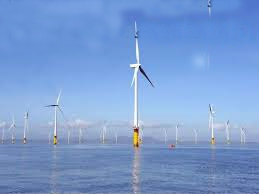

21/12/2017
Wind energy overtakes coal as the EU’s second largest form of power capacity but concerns remain over politicians’ enthusiasm for renewables
Renewable energy sources made up nearly nine-tenths of new power added to Europe’s electricity grids last year, in a sign of the continent’s rapid shift away from fossil fuels. But industry leaders said they were worried about the lack of political support beyond 2020, when binding EU renewable energy targets end. Of the 24.5GW of new capacity built across the EU in 2016, 21.1GW or 86% was from wind, solar, biomass and hydro, eclipsing the previous high-water mark of 79% in 2014.
 |
|
The London Array site in the North Sea, the largest offshore windfarm in the world (Getty source) |
For the first time windfarms accounted for more than half of the capacity installed, the data from trade body WindEurope showed. Wind power overtook coal to become the EU’s second largest form of power capacity after gas, though due to the technology’s intermittent nature, coal still meets more of the bloc’s electricity demand. In details, Germany installed the most new wind capacity in 2016, while France, the Netherlands, Finland, Ireland and Lithuania all set new records for windfarm installations. The total capacity added was 3% down on 2015 but a surge in offshore windfarms which are twice as expensive as those built on land being connected in Britain saw total, Europe-wide investment hit a record €27.5bn (£23bn). The biggest project was the Gemini windfarm off the Netherlands’ coast, which was connected to the grid last February and will be the world’s second largest offshore windfarm when finished this year. Gemini was followed in size by two other offshore windfarms, Germany’s 582MW Gode Wind 1 and 2, and the Netherlands’ 144MW Westermeerwind project.
Despite Europe’s installed wind power capacity now standing at 153.7GW, it is still a relatively small fraction of the region’s 918.8GW of total power capacity. The industry is hoping much of its growth will come from filling the gap as governments force old coal power plants to close to meet climate change goals, as the UK has coammitted to doing by 2025. According to WindEurope’s new report, 2016 European Statistics, paints a picture of a Europe increasingly divided on wind power. Spain, Portugal, Italy and Greece, which together drove much of the growth in new windfarms in the noughties, now amount to a tiny fraction of new installations. Poland last year passed a law limiting how close wind turbines can be to buildings, effectively stalling the industry there.
The result is an increasingly small number of countries connecting serious amounts of new wind power. Germany, which already has three times as much wind power as any other EU country, installed 44% of Europe’s new wind capacity last year. Dickson said the wind power industry will be lobbying Europe’s capitals for more support in their national energy and climate plans, which member states, including the UK, have to submit to the European commission in draft form by the year’s end■
Trần Tân
(Source: WindEurope)